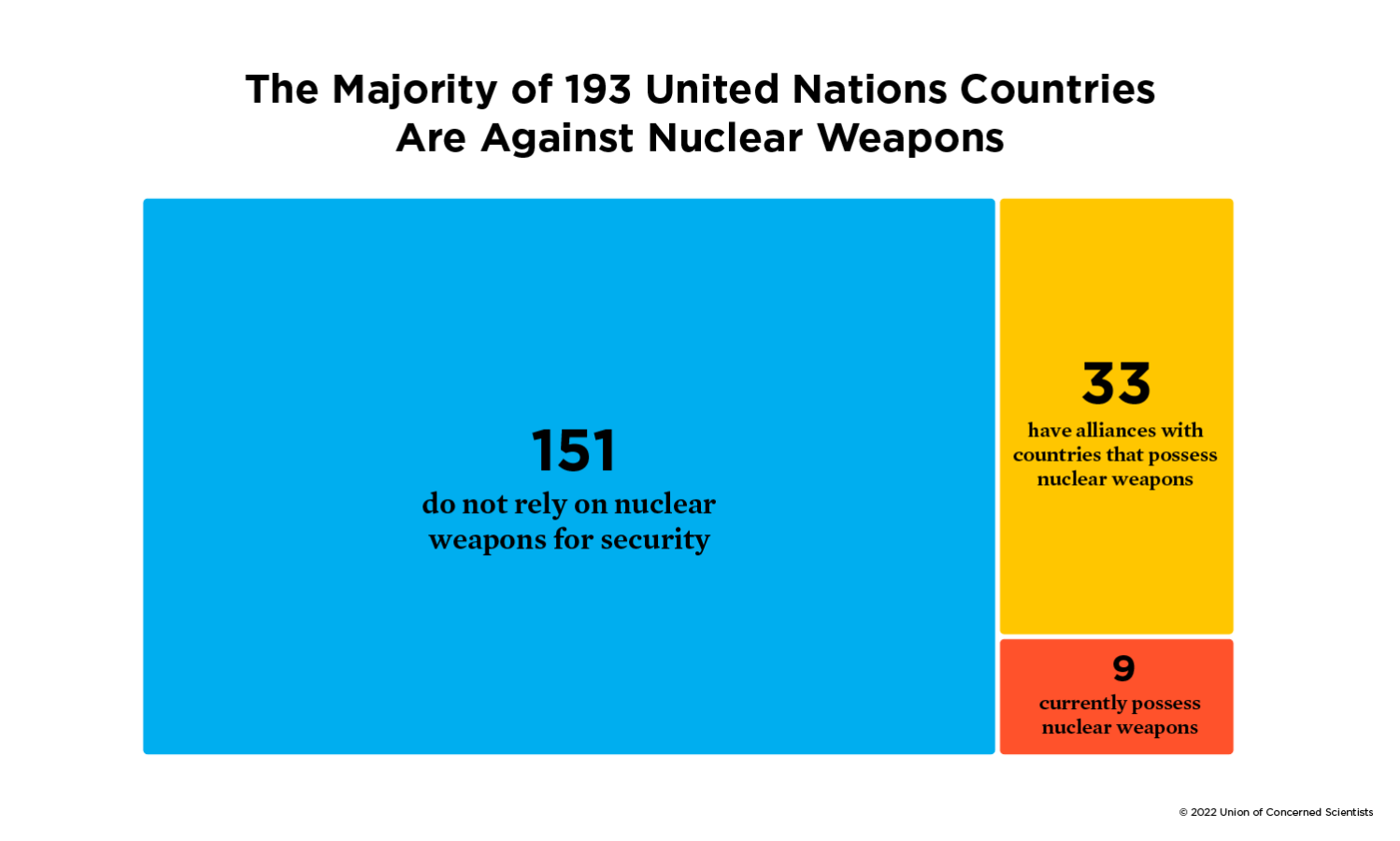The Treaty on the Prohibition of Nuclear Weapons (TPNW) entered into force in early 2021, for the first time defining nuclear weapons as illegitimate tools of war under international law. In Vienna from June 21-23, states parties gathered for the first time alongside other state observers, civil society groups, and survivors of nuclear use, testing, and development to define concrete steps towards implementing the obligations of the treaty. At its conclusion, states parties adopted the Vienna Declaration and 50-point Action Plan.
The Vienna Declaration
The Vienna Declaration is a forceful statement against nuclear weapons. It reaffirms the treaty’s goal of a world without nuclear weapons and asserts “that the risk of a nuclear weapon detonation by accident, miscalculation or design concerns the security of all humanity.”
The Declaration also addresses the growing risks of nuclear war. Members were divided on whether to explicitly condemn Russia’s invasion of Ukraine and escalating threats of nuclear use; many participating states issued statements condemning Russian aggression, but others did not. Ultimately, while the Declaration acknowledged an environment of “increasingly strident nuclear rhetoric,” it did not single out Russia. Instead, the Declaration “[condemns] unequivocally any and all nuclear threats, whether they be explicit or implicit and irrespective of the circumstances.”
While Russia’s recent nuclear threats are particularly egregious and irresponsible, they are unfortunately not unique. Other nuclear powers engage in similar rhetoric, using the threat of nuclear use not for their own defense but as a coercive tool of policy. Former US President Donald Trump repeatedly issued such threats during his administration. National populist leaders like Vladimir Putin and Donald Trump are more likely to resort to dangerous rhetoric and take risks in pursuit of their goals. As national populism continues to rise in nuclear-armed states, norms of nuclear restraint will continue to erode.
However, nuclear threats do not only come from national populists through speeches or tweets. The threat of nuclear use is fundamental to the security of every nuclear-armed state and any other state that relies on nuclear deterrence. Nuclear deterrence is the threat of nuclear use, issued in the hope that the risk of catastrophic humanitarian disaster will disincentivize conflict. Helplessness, uncertainty and terror are foundational to theories of nuclear deterrence – this is how the system works by design.
The Vienna Declaration denounces not a single bad actor but the very practice of nuclear deterrence, a system which both permits and perpetuates Russia’s nuclear coercion. While nuclear powers and their allies recommit indefinitely to global terror through nuclear deterrence, the Vienna Declaration is a timely reminder that most states have explicitly rejected the threat of mass destruction as a form of security. Nine states possess nuclear weapons. Another 33 states have or will soon have collective security relationships with nuclear powers. They include:
- NATO’s 27 non-nuclear member states (6 of which host US nuclear weapons)
- Soon-to-be NATO members Finland and Sweden
- Australia, Japan, and South Korea, which have military alliances with the United States
- Belarus, which may soon host Russian nuclear weapons
That leaves 151 states that do not rely on nuclear weapons in any form for their security. All but one of those states (South Sudan) have committed to never develop or possess nuclear weapons as members of the Nuclear Non-Proliferation Treaty (NPT). 114 of those states are members of regional nuclear-weapons-free zones. 66 (so far) have signed and ratified the TPNW – for many, joining the TPNW is the third time they have formally affirmed their commitment to abstain from nuclear weapons.

Nuclear weapons are not inevitable or irreplaceable. Most governments and most people in the world have chosen not to seek their own security through the threat of mass destruction.
The Action Plan
State parties also adopted a 50-point Action Plan. This document contains concrete actions for members of the TPNW to advance nuclear disarmament and fulfill their obligations under the treaty. Many of these provisions relate to the treaty’s ‘positive obligations:’ measures to reduce both the past, present, and future harm caused by nuclear weapons. The treaty obliges its members to provide victim assistance and environmental remediation for frontline communities impacted by nuclear use, testing, and development.
The humanitarian impacts of nuclear weapons are widespread, affecting people all over the world. The nuclear age began with the destruction of the cities of Hiroshima and Nagasaki, creating hundreds of thousands of casualties and leaving behind generations affected by the consequences. In the following 70 years, over 2,000 nuclear tests were conducted throughout North America, Eurasia, Africa, and the Pacific. Further environmental contamination resulted from mining, development, production, waste storage, and disposal activities related to nuclear weapons. Indigenous communities and people of color have disproportionately born the health and environmental consequences of nuclear weapons, and, in most cases, those harms have not been addressed. In the Action Plan, states parties committed to
- consult closely with affected communities and international organizations to develop sustainable, effective, and detailed plans for victim assistance and environmental remediation.
- appoint government officials and adopt national laws and policies required to carry out that work.
- establish voluntary reporting on national initiatives and progress.
- provide technical, material, and financial assistance to states in need of additional support that have been affected by nuclear weapons.
- develop guidelines for how to address age- and gender-specific nuclear harm.
The Action Plan also emphasizes the role of scientific and technical expertise in creating a shared understanding of the humanitarian impact of nuclear weapons and guiding implementation of the treaty. The Action Plan calls for states parties to
- establish a Scientific Advisory Group to advise treaty members and aid in achieving the treaty’s goals.
- create a broad network of experts from relevant fields that are diverse in terms of geography and gender.
Beyond the immediate objectives of the Action Plan, this document is also meaningful as a sign of forward momentum on nuclear disarmament issues. It represents the first conclusive plan of work to result from multilateral disarmament efforts in over a decade. In the past, review conferences for the NPT have been seen as important opportunities to make progress on nuclear disarmament, a key pillar of the treaty. The 2010 NPT Review Conference produced an action plan for the first time, but it was never fully implemented. The 2015 Review Conference failed to produce a consensus document, in large part because of a lack of progress on the 2010 action plan. Prospects for a better outcome during the 2022 Review Conference this August are bleak.
Meanwhile, the Conference on Disarmament, established to be the primary forum for disarmament negotiations, has not produced an arms control agreement since the 1996 Comprehensive Nuclear Test Ban Treaty. As tensions between nuclear powers rise, there is little hope of a breakthrough in the foreseeable future.
The TPNW’s first meeting of states parties was not just a review of treaty progress but an international forum for states to work collaboratively on nuclear disarmament issues and to create a plan for moving forward. While states possessing nuclear weapons have boycotted the TPNW, several states that rely on nuclear deterrence through NATO engaged constructively with the conference as observers. Hopefully that meeting will only be the first among many such opportunities, and the action plan that resulted will be the first of many such action plans.
The states parties expressed in the Vienna Declaration that they “have no illusions about the challenges and obstacles that lie before us,” but that they will “move ahead with optimism and resolve.” They offer no false hope that the destination is easy or close, but at least one more pathway is open.

